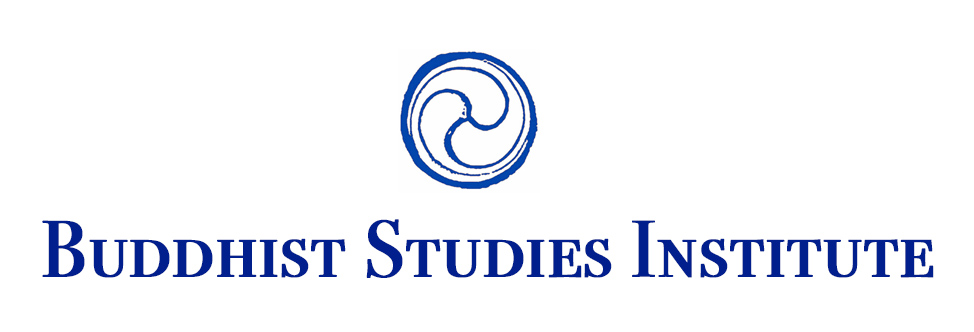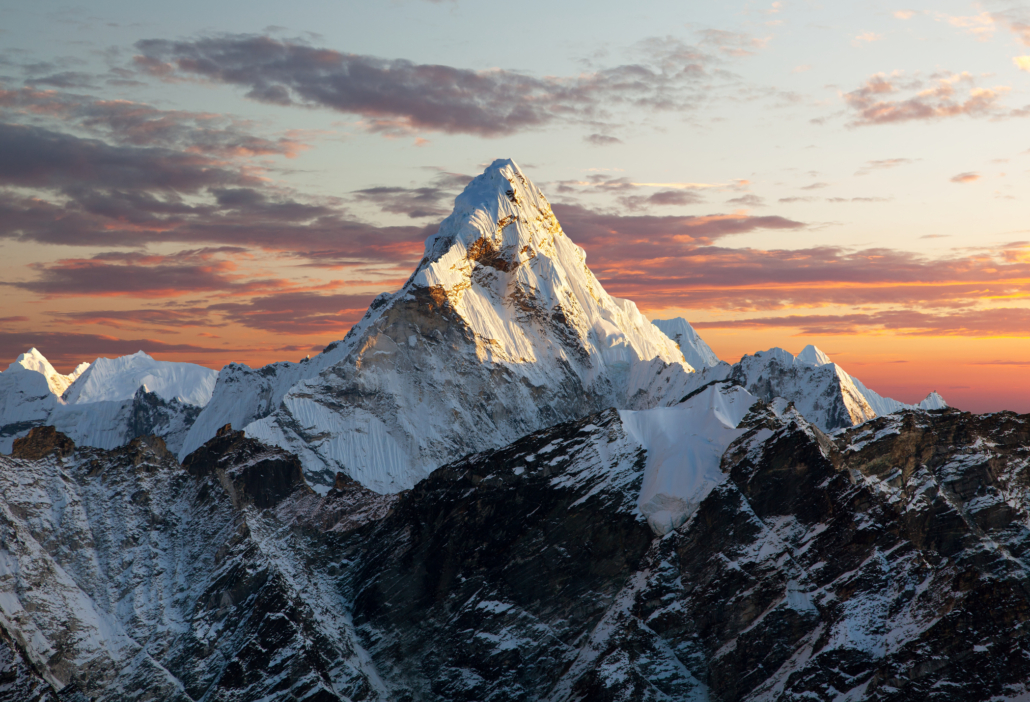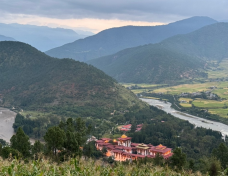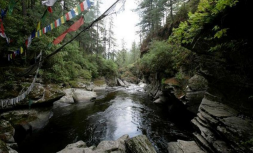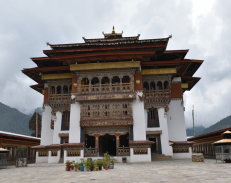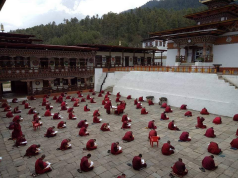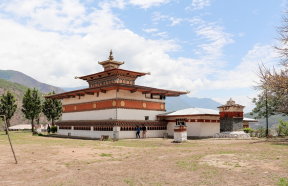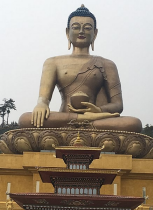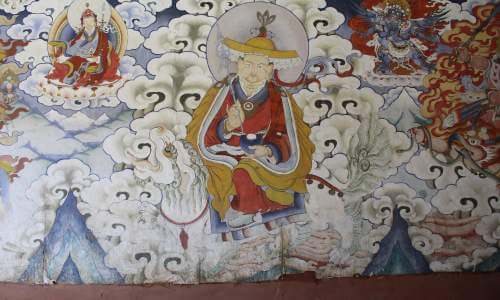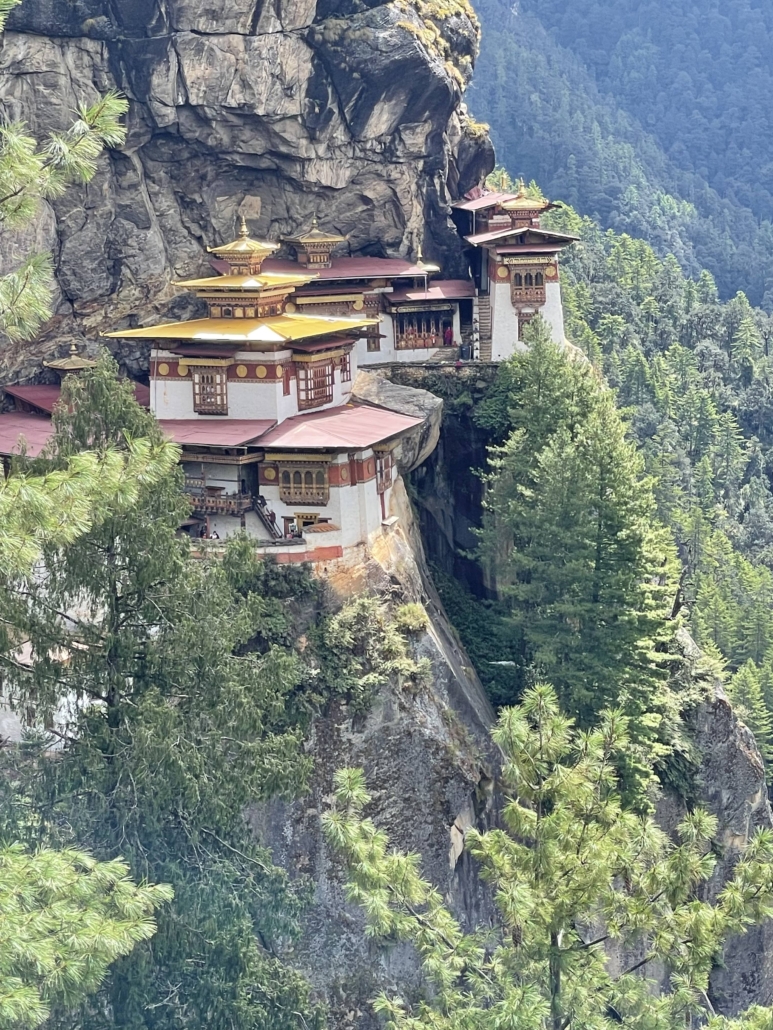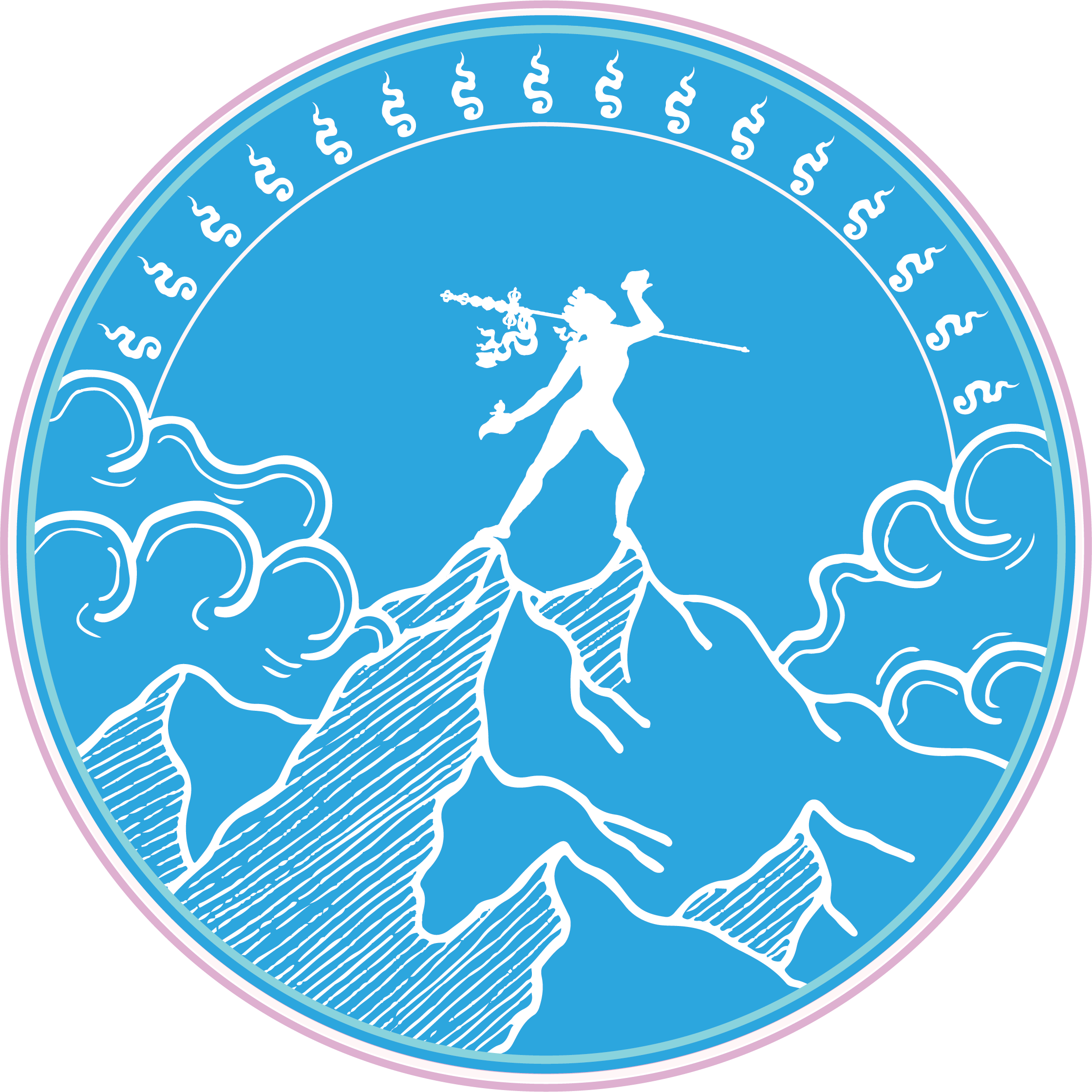Join us as we make this rare pilgrimage to the magical Himalayan Buddhist kingdom of Bhutan, led by Vajrayana author and teacher Jampa Mackenzie Stewart and scholar-practitioner/Vajrayana teacher Dr. Pema Khandro, as well as local lamas and yogis, on a journey in the footsteps of the incomparable master Kunkhyen Longchen Rabjam (1308-1364AD), most known as Longchenpa, the towering fourteenth-century Dzogchen (Great Perfection) adept, meditator, author, poet, and philosopher. Longchenpa was one of the greatest and most famous lamas ever to have lived in Tibet and Bhutan, after Guru Padmasambhava and Vimalamitra.
Little or nothing is mentioned in his Tibetan biographies of Longchenpa’s 10 years of self-exile in Bhutan from ages 43 to 53, in the prime of his life. Yet during this time, he traveled throughout Bhutan, where he meditated, wrote, taught well over 100,000 disciples, and established eight famous monasteries and hermitages, his “lings” or estates, some of which are still active today. Here is a precious opportunity to practice his meditations and to listen to the words of Longchenpa’s pinnacle treatises on the hallowed grounds where he himself walked, to meet some of his blood descendants, and to view Bhutan’s majestic mountain vistas, caves, and temples where Longchenpa sat and performed his meditations and yogic practices.
We will also be guided in daily practices originally taught by Longchenpa, as well as hearing his profound teachings on our true nature of mind. On the way, we will also visit numerous other sites sacred to masters such as Padmasambhava, Dakini Yeshe Tsogyal, Pema Lingpa, Drukpa Kunley, Dakini Machig Labdron, Thangtong Gyalpo and more.
This journey is open to everyone, regardless of Buddhist background, meditative experience, or level of physical fitness. We will accommodate your level of fitness and desired activity, with opportunities for more vigorous climbs and hiking as well as more relaxing tour alternatives and therapeutic options such as massages and hot stone baths.
Bhutan is known as the last Shangri-La, and its pristine natural beauty of its mountains, rivers and forests will refresh and soothe your body and spirit. You will have the pleasure to drink in Bhutan’s unique Tantric Buddhist culture, architecture, art, and glorious Himalayan countryside, along with experiencing the only country in the world whose national priority is GNH – “gross national happiness.” You will delight in experiencing the warm and cultured local people that you meet, most of whom speak English. There will be time for leisure, shopping, sightseeing and walks on your own in this pilgrimage journey through the last independent Himalayan Buddhist kingdom.
Bhutan Pilgrimage Itinerary
Day 1 – Wednesday, October 2nd
Group flight from either Bangkok, Thailand or New Delhi, India to Paro, Bhutan. We may be given a chance to see the snow-covered peaks of Mt. Everest and Kangchenjunga, as well as Bhutan’s sacred mountain Chomolhari (24,035 feet). After touching down in Paro, representatives will meet you for a ride to your hotel, after which a visit to Kyichu Lhakhang, one of the oldest and most sacred temples in Bhutan, built in the 7th century A.D. by the Tibetan emperor Songsten Gampo. Another important site to visit is Paro Dzong, a stunning monastery-fortress located above Paro. An architectural marvel, it hosts one of the finest examples of Bhutanese art and architecture in the world. If time, sightseeing and shopping in downtown Paro. In the evening, traditional welcome Bhutanese dinner and orientation session. Overnight in Paro at Tenzin Ling Resort
*Make sure to arrive in Bangkok or New Delhi no later than October 1st.
Day 2 – Thursday, October 3rd
This morning begins with optional meditation, Qigong and/or yoga, as will most of our days in Bhutan. Following a delicious breakfast, we will drive 10 minutes to the Paro airport to fly to Trashigang Valley in eastern Bhutan. This 30-minute domestic flight offers a stunning and scenic view. After landing in Trashigang we will drive to Lhuentse Valley (Kurtoe), where the Big Guru Rinpoche Statue is located on Takila Hill, overlooking the valley. We will be staying for 3 nights at Takila Guest House lodge, right next to the Guru Rinpoche Statue. This will provide time for teaching and practices at Takila’s Guru Rinpoche Lhakhang. Night halt at Takila Guesthouse in Lhuentse.
Day 3 – Friday, October 4th
After breakfast, our morning continues with exploring and meditating at the largest statue of Guru Rinpoche in the world. From there, we will visit Kurtoe Kunzangling, the first of the Eight Lings of Longchenpa and one of the most magnificent ones in Bhutan. Night halt at Takila Guesthouse in Lhuentse.
Day 4 – Saturday, October 5th
After breakfast, we will visit the sacred Goenpa Temple of Machig Labdron, the female lama-yogini and founder of the Chod practice in Tibet and Bhutan. This is the only temple in the world fully dedicated to Machig Labdron. Teaching and practices and Chod ceremony with local Ngakpas and Ngakmas. Night halt at Takila Guesthouse.
Day 5 – Sunday, October 6th
In the morning we will depart from Lhuentse for the journey to Bumthang, the heartland of Bhutan and Longchenpa’s main area. on a beautiful and scenic drive through Thrimshingla National Park. If we are lucky, we might see a red panda, a rare and endangered species that enjoys this park as one of its few natural habitats in the world. In Bumthang we will be staying at Ogyen Choling, the second of Longchenpa’s Eight Lings, in the Tang Valley. We will be staying 3 nights here, at Ogyen Choling Heritage House. Note: The drive will be 7 hours (about 180 kms).
Day 6 – Monday, October 7th
In the morning, we will explore Ogyen Choling. Tang Valley is the real beyul or hidden land, in Bhutan. an area of Bumthang that was first blessed by Guru Rinpoche, later by Longchenpa, then by Dorje Lingpa in the 14th century, and was the birthplace of Pema Lingpa, the subsequent incarnation of Longchenpa in the 15th century who revealed many termas here. It is also the site of the first Governor of Bhutan, before the first king. We will take a 15-minute hike from Ogyen Choling Temple up to Longchenpa’s cave, and one of the two main sites where he practiced togal, or the leap-over into spontaneous presence, considered to be the highest practice in Buddhism. We will pause there for teachings and practice. Night halt in Bumthang at Ogyen Choling Heritage House.
Day 7- Tuesday, October 8th
Today we will hike from Ogyen Choling up to Thowadrak (High Rock), a truly sacred place, one of the “four rocks” or four special practice places of Guru Rinpoche in Bumthang. Thowadrak was also where the famous nun Gelongma Palmo came, recited OM MANI PADME HUM many millions of times and cured herself of leprosy. Here, Thowadrak Lama Pema Sherab Dorji, the great 85 year old resident hermit- yogin pictured here, may give us transmissions on Vajrakilaya, Tara, and Dzogchen Nyingthig. Night halt at Ogyen Choling Heritage House.
Day 8 – Wednesday, October 9th
Local sightseeing around Tang Valley and visit to Tak-Rimochen Temple (Guru Rinpoche Temple and Pema Lingpa Temple), and visit to Mebar Tso, the Burning Lake, where Terton Pema Lingpa where Terton Pema Lingpa dove in and discovered many terma treasures. Visits to Kuje Monastery and the 7th century Jampa Lhakhang, both temples connected to the tantric guru Padmasambhava. Night Halt in Bumthang Jakar at Mountain Resort.
Day 9 – Thursday, October 10th
Today we will visit Shingkhar Dechenling in Ura, the third of Longchenpa’s Eight Lings, and hopefully meet the Shingkhar abbot, Ngodup Rinpoche, a direct blood descendant of Longchenpa. We will also visit Samling Naktshang – the palace of Longchenpa and the descendants of Longchenpa in Bhutan in Chumey Valley, which is below Tharpa Ling.
Night Halt in Bumthang Jakar at Mountain Resort.
Day 10 – Friday, October 11th
On this day, we will visit Tharpa Ling, the fourth of Longchenpa’s Eight Lings and his foremost monastery. Tharpa Ling literally means “the place of liberation.” It was also used as a place of meditation by Jigme Lingpa, Nyoshul Khen Rinpoche, and Dilgo Khyentse Rinpoche. Tharpa Ling is the first ever higher Buddhist studies university in Bhutan. In the olden days, it was compulsory that all the Je Khenpos (the chief abbot of the central monastic body in Bhutan today) had to enroll here before they could become the chief abbot. We then will hike up to the throne of Longchenpa, Longchenpa Zhugthri. After lunch, we will continue our journey from Bumthang to Gangtey Lodge, just below Gangtey Goenpa, one of the oldest monasteries in Bhutan and the seat of Gangteng Tulku Rinpoche, the 9th body emanation of terton Pema Lingpa, who was himself the 15th century reincarnation of Longchenpa. Night Halt in Gangtey Goenpa.
Day 11 – Saturday, October 12th
At Gangtey, we will embark on the beautiful Gangteng Nature Hike through pristine Phobjika Valley and enjoy lunch at a farmhouse. Here we will visit Gangtey Ngelung Drechagling, the fifth of Longchenpa’s Eight Lings, located in Phobjika Valley near Gangtey Goenpa. Ask politely and the caretaker may bless you with an old thangka (painted or embroidered religious picture) whose back bears the handprint of Longchenpa printed in his own nose blood; a golden statue made in Longchenpa’s own image; and an iron skillet made by Pema Lingpa (a blacksmith as well as a lama and terton), with his thumbprints in it.
The chapel next door is dedicated to the Dzogchen protector deity Dza Rahula, whose nine-headed body is covered with eyes and has a snake’s lower half. The bowl of sacred water here comes from a nearby spring and is claimed to have the power to cure epilepsy and paralysis. The caretaker can point you toward a 10-minute walk to the huge centuries-old cypress tree said to have been sprouted from Longchenpa’s upside-down walking stick. On the way back, you can stop at two sacred springs at the base of the hill, where pilgrims fill up bottles of drub chhu (holy water). Night at Gangtey Goenpa.
Day 12 – Monday, October 13th
Morning travel from Gangtey Geonpa to visit to Sha Khotha Rinchenling, also known as Rinchenling Shedra, [2 hour drive] the sixth of the Eight Lings, dating back to the 14th century established by Longchenpa. Now an important monastery and shedra of the Drukpa Kagyu school of Buddhism, it is in this picturesque place where, in wintertime, the renowned black-necked cranes visit central Bhutan from Tibet.
After lunch, we will visit Menlok Sha Kunzangling, [25 minute drive] the seventh of Longchenpa’s Eight Ling sites. Today the temple is popularly known as Lhakhang Thangka. The history behind this temple, based on the oral tradition shared by the caretaker, is as follows. A child of a house above the site where the temple stands today, fell seriously ill due to the influence from what was diagnosed as evil spirits. At that time, Longchenpa happened to pass by and was invited to the house. After Kunkhyen Longchenpa gave her and the house a Protection Blessing, the child recovered. This aroused a deep sense of faith and devotion to the Kunkhyen in the hearts of the family, and in gratitude, they offered him the land on which Longchenpa built this temple, consecrated it and blessed it himself. Night halt in Punakha.
Day 13 – Monday, October 14th
We will be waking up in the lush valley of Punakha, with its green terraced fields of red rice and winter wheat. Here, we’ll enjoy a short hike to Chimi Lhakhang, a small temple dedicated to Drukpa Kunley, the 14th century saint affectionately called “the Divine Madman.” Drukpa Kunley is one of Bhutan’s favorite holy men, in spite of — or because of — his irreverent and ribald way of teaching the Dharma. The valley is peppered with his influence, and the villages still recount his legendary exploits.
Here we will also visit the famous Punakha Dzong (the Palace of Great Happiness), located at the confluence of the male and female rivers. The Punakha Dzong is the winter residence for the central monastic body and is the ancient capital city of Bhutan. The place is very blissful and significant in Bhutan’s history. It is a marvelous and magical place with a stunning view, renowned as a replica of Guru Rinpoche’s paradise, Zangdok Palri.
Night halt in Punakha.
Day 14 – Wednesday, October 15th
We will journey from Punakha to Paro via a famous mountain pass called Dochula Pass, with 108 stupas beautifully located on the mountain top with the most spectacular views of the highest snow peaked mountain of Bhutan. The pass is located shortly before reaching the capital city of Thimphu.
We will stop over in Thimphu for lunch and shopping, after which we will visit the Great Buddha Dordenma, the biggest buddha statue in Bhutan, before we drive on to Paro. Night halt in Paro at Tenzin Ling Resort.
Day 15 – Wednesday, October 16th
Visit for teaching and practice at Paro Samtenling, the eighth of Longchenpa’s Eight Ling, and Dumtse Lhakhang, a small temple en route to Paro Dzong known for its exceptional murals and paintings depicting the life of Shakyamuni Buddha. Night halt in Paro at Tenzin Ling Resort.
Day 16 – Thursday, October 17th
Hike up to Tiger’s Nest, (Paro Taktsang), one of the holiest pilgrimage sites in Bhutan, sacred to Guru Rinpoche, Dakini Yeshe Tsogyal and Machig Labdron. Farewell celebration dinner and party. Night halt in Paro at Tenzin Ling Resort.
Day 17 – Friday, October 18th
Departure for Bangkok or New Delhi.
About the Pilgrimage Leaders
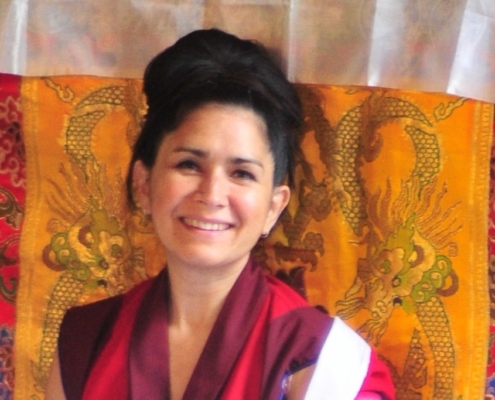
Pema Khandro, PhD
Pema Khandro is an internationally renowned teacher and scholar of Buddhist philosophy. She is the founder of Ngakpa International and its three projects, The Buddhist Studies Institute, Dakini Mountain and the Yogic Medicine Institute. In her work as a Buddhist teacher she is an authorized Lama and lineage holder of the Nyingma and Kagyu traditions and was enthroned to carry on the lineage of her predecessor, the first Pema Khandro, an early twentieth century yogini from Eastern Tibet. She has led a vibrant world-wide community since 1999. Through the Buddhist Studies Institute, she also offers a complete curriculum of training in Tibetan meditation and Buddhist Philosophy. She has a bachelor’s degree in Sociology, a Master’s degree specializing in Tibetan studies, and a Ph.D. in Buddhist Studies from the University of Virginia. Her scholarly research focuses on the history of Dzogchen and on Women in Tibetan Buddhism.
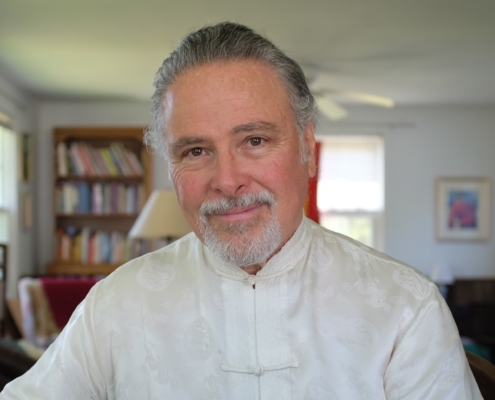
Jampa Stewart
Studying with many masters, including the Dalai Lama, Jampa Stewart is now authorized as a Dharma teacher in the Kagyu, Nyingma, and Bon Buddhist lineages. He founded the Rochester Dharma Study Group and co-founded the Amitabha Foundation in 1986. He later served on the board of directors of Yeshe Khorlo, and established a branch chapter in Austin, Texas.
As an author, Stewart has written two published books and over 50 magazine articles on Traditional Chinese Medicine, Taoism, Buddhism, Tai Chi and Qigong, and served as contributing writer and editor for three of Mantak Chia’s books on Taoist practice. He was a contributing writer and editor of Chinese Medical Qigong Therapy (2000, first edition), the world‘s comprehensive and leading textbook on the art. He was editor and publisher of The T’ai Chi Journal, a quarterly Tai Chi magazine.
Registration Details
Your cost for this sixteen-day journey, excluding international travel to and from Bangkok or New Delhi, and including double occupancy lodgings, is US $5,785. For single room lodging the cost is US $6,374, or about $35 more per night.
[Note that $1,600 of the total cost includes a $100 per day non-negotiable tourism tax called the Sustainable Development Fee, charged by the Bhutanese Government since July 2023. The actual trip costs aside from that
have been kept to a minimum.]
These prices include: hotels, all meals (both vegetarian and non-vegetarian choices), local transportation (including domestic airfare in Bhutan), transportation in minibuses, site admission fees, all group related tips
and gratuities, all teachings and scheduled activities, Bhutan Visa Fees and Sustainable Development Fees.
The price does not include international airfare into and out of Bhutan, but our partner agency will book these for you for no additional cost. At present, the approximate cost of roundtrip airfare from Bangkok, Tailand to Paro is $936. Roundtrip from Delhi, India to Paro is approximately $589. These costs of your roundtrip airfare can be added to your fnal trip payments or paid separately. It also does not include roundtrip international airfare to Bangkok or Delhi.
To reserve a place and register, please either send a deposit of $2,000 or pay in full (preferred for ease of administration) to the following account:
Venmo: @jampa-stewart
or
Bank Name: TD Bank Routing Number: 0111-03093
Account Name: Valley Spirit Wellness LLC ABA: 031101266
Jampa Mackenzie Stewart Swift Code: NRTHUS33XXX
Account Number: 4427630531
Business Address: P.O. Box 261, Washington Depot, Connecticut 06794, U.S.A.
You should submit your registration and deposit or full payment by April 30, 2024 to be assured a place. Balance of any remaining payment is due by July 31st, 2024. By the same date, please also email us your completed Personal Information Form, and a photo or PDF file of the photo along with the signature page of
your current passport which will be required to obtain your Bhutan Visa.
Your trip fees are fully refundable up until July 31st, 2024.
If you cancel after July 31 yet before August 31st, you’ll receive a 50% refund.
If you cancel after August 31st, no refund will be possible due to our agreement
with our partner agency in Bhutan.
Once registered, you will receive further trip updates, reading lists, packing instructions and other practical recommendations periodically.
